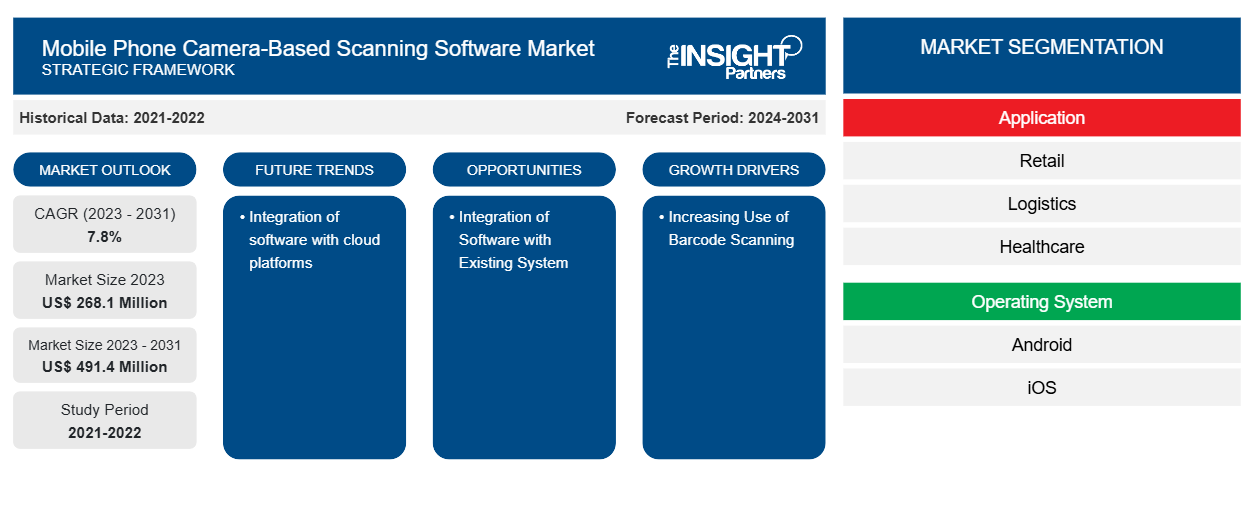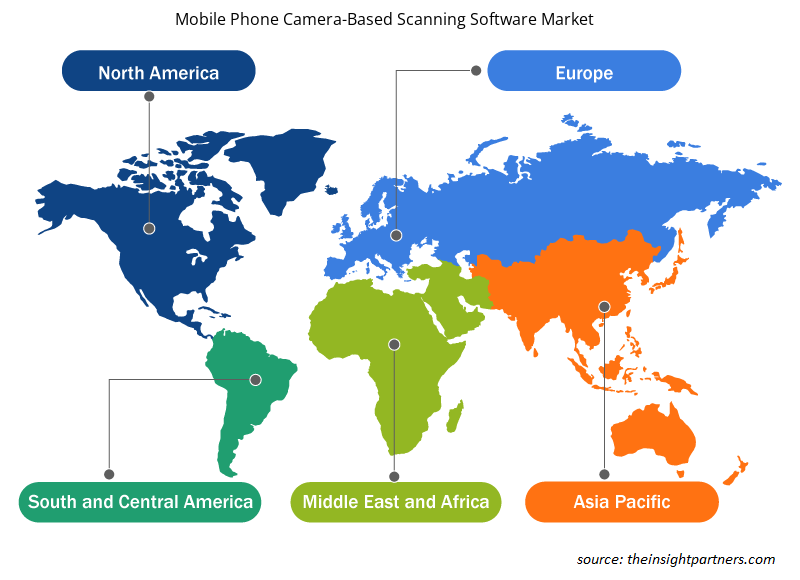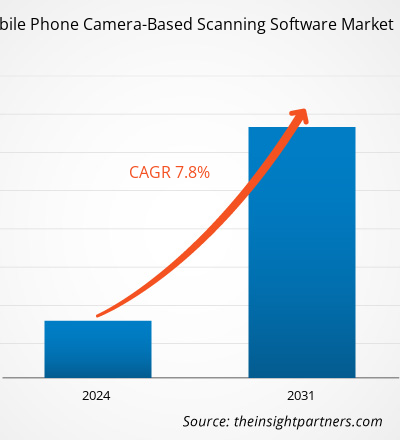Si prevede che la dimensione del mercato del software di scansione basato sulla fotocamera del telefono cellulare raggiungerà i 491,4 milioni di dollari entro il 2031, rispetto ai 268,1 milioni di dollari del 2023. Si prevede che il mercato registrerà un CAGR del 7,8% nel periodo 2023-2031. È probabile che l'integrazione del software con le piattaforme cloud rimanga una tendenza chiave nel mercato.
Analisi di mercato del software di scansione basato sulla fotocamera del telefono cellulare
Il software di scansione è pronto a trasformare il modo in cui operano le aziende, offrendo una moltitudine di vantaggi rispetto ai tradizionali scanner di codici a barre hardware. Adottando una soluzione di scansione basata su software, le aziende possono aumentare l'efficienza, migliorare la precisione e ottenere informazioni preziose, con conseguente crescita e successo. Il software di scansione dei codici a barre ha rivoluzionato vari settori, tra cui la vendita al dettaglio, per semplificare la gestione dell'inventario, il monitoraggio dei prodotti e i processi di pagamento. Nella logistica, automatizzando la raccolta dati, il monitoraggio delle spedizioni e ottimizzando le operazioni di magazzino. Nell'assistenza sanitaria, migliorando l'identificazione dei pazienti, la somministrazione dei farmaci e la gestione delle cartelle cliniche.
Panoramica del mercato del software di scansione basato sulla fotocamera del telefono cellulare
Il software di scansione dei codici a barre utilizza algoritmi software per decodificare i codici a barre raccolti con fotocamere digitali o dispositivi mobili. A differenza degli scanner di codici a barre hardware, che necessitano di apparecchiature specialistiche, le soluzioni software per codici a barre possono essere integrate nei dispositivi e nelle applicazioni correnti, offrendo maggiore flessibilità e risparmi sui costi. Il software di scansione è comunemente definito API per scanner di codici a barre o semplicemente API per codici a barre. Il software di scansione dei codici a barre offre una moltitudine di vantaggi rispetto ai tradizionali scanner di codici a barre hardware. Offre flessibilità e le soluzioni possono essere facilmente adattate a vari scenari di scansione e configurazioni di fotocamere, rendendole adatte a una varietà di applicazioni. Il software che elimina la necessità di hardware specializzato riduce i costi iniziali. Inoltre, le soluzioni software di scansione spesso richiedono una manutenzione e degli aggiornamenti minimi, riducendo i costi a lungo termine.
Personalizza questo report in base alle tue esigenze
Riceverai la personalizzazione gratuita di qualsiasi report, comprese parti di questo report, o analisi a livello nazionale, pacchetto dati Excel, oltre a usufruire di grandi offerte e sconti per start-up e università
Mercato del software di scansione basato sulla fotocamera del telefono cellulare: approfondimenti strategici

-
Scopri le principali tendenze di mercato in questo rapporto.Questo campione GRATUITO includerà analisi di dati che spaziano dalle tendenze di mercato alle stime e alle previsioni.
Driver e opportunità di mercato per il software di scansione basato sulla fotocamera del telefono cellulare
Aumento dell'uso della scansione dei codici a barre per favorire il mercatoBarcode Scanning to Favor Market
Le aziende, i magazzini e le altre strutture che si affidano all'immissione manuale dei dati soffrono di un alto tasso di errori umani. I dipendenti che inseriscono i dati manualmente hanno troppe probabilità di invertire i numeri, saltare una riga, fraintendere un numero o usare una grafia terribile che altri non riescono a leggere. I codici a barre, d'altro canto, riducono significativamente la probabilità di errore umano fino al punto di eliminarlo quasi del tutto. Le scansioni dei codici a barre sono più efficienti, affidabili e richiedono meno tempo rispetto all'immissione manuale dei dati. Anche le aziende che hanno difficoltà a ridurre i costi di gestione dell'inventario traggono vantaggio dall'implementazione di programmi di codici a barre. I codici a barre consentono alle aziende di aggiornare l'inventario in tempo reale con aggiornamenti immediati e accurati che forniscono conteggi di inventario reali. Conteggi di inventario più accurati contribuiscono a migliorare l'efficienza perché consentono alle aziende di stabilire tempi di consegna più accurati, una definizione più accurata dei costi di inventario e un prezzo di mercato più elevato. Aumentando così l'uso dei codici a barre e guidando la crescita del software di scansione dei codici a barre basato su telecamera.Barcodes, on the other hand, significantly reduce the likelihood of human error to the point of almost eliminating it. Barcode scans are more efficient, reliable, and less time-consuming than manual data entry. Companies that are struggling to reduce inventory carrying costs also benefit from implementing barcode programs. Barcodes empower companies to update inventory in real time with immediate, accurate updates that deliver true inventory counts. More accurate inventory counts contribute to improved efficiency because they enable companies to establish more accurate delivery times, a more accurate definition of inventory costs, and a higher price to market. Thus increasing us of barcodes and driving the growth of camera-based barcode scanning software.
Integrazione del software con il sistema esistente
Il software di scansione basato sulla fotocamera del telefono cellulare offre una gamma di funzionalità e capacità che vanno oltre la tradizionale scansione dei codici a barre, tra cui la raccolta dati, l'elaborazione e l'integrazione con sistemi o software esistenti. Possono sincronizzare i dati con database centrali, comunicare con sistemi POS o software di gestione dell'inventario e trasferire informazioni in modalità wireless per garantire aggiornamenti e accuratezza in tempo reale. Questo software può essere personalizzato o sviluppato per integrarsi perfettamente con sistemi esistenti come software di gestione dell'inventario, sistemi di punti vendita (POS), software di gestione delle relazioni con i clienti (CRM) e sistemi di pianificazione delle risorse aziendali (ERP). Questa compatibilità consente alle aziende di sfruttare la propria infrastruttura software esistente, ottimizzando l'efficienza operativa nella misura più ampia possibile. Pertanto, l'integrazione con i sistemi esistenti crea un'opportunità per la crescita del marcatore.barcode scanning, including data collection, processing, and integration with existing systems or software. They can synchronize data with central databases, communicate with POS systems or inventory management software, and transfer information wirelessly to ensure real-time updates and accuracy. This software can be customized or developed to seamlessly integrate with existing systems like inventory management software, point-of-sale (POS) systems, CRM) software, and enterprise resource planning (ERP) systems. This compatibility empowers businesses to harness their existing software infrastructure, optimizing operational efficiency to the fullest extent possible. Thus, integration with existing systems creates an opportunity for the growth of the marker.
Analisi della segmentazione del rapporto di mercato del software di scansione basato sulla fotocamera del telefono cellulare
I segmenti chiave che hanno contribuito alla derivazione dell'analisi di mercato del software di scansione basato sulla fotocamera del telefono cellulare sono l'applicazione e il sistema operativo.
- In base all'applicazione, il mercato dei software di scansione basati sulla fotocamera dei telefoni cellulari è segmentato in vendita al dettaglio, logistica, assistenza sanitaria, ospitalità, servizi postali e altri.
- Per quanto riguarda i sistemi operativi, il mercato è segmentato in Android e iOS.
Analisi della quota di mercato del software di scansione basato sulla fotocamera del telefono cellulare per area geografica
L'ambito geografico del rapporto di mercato sui software di scansione basati su fotocamera per telefoni cellulari è principalmente suddiviso in cinque regioni: Nord America, Asia Pacifico, Europa, Medio Oriente e Africa e Sud e Centro America. Il Nord America è un paese sviluppato con la presenza di vari sviluppatori di software e fornitori di soluzioni digitali. Le aziende in tutto il Nord America stanno adottando soluzioni software e digitali. Lo sviluppo della tecnologia degli smartphone sta diventando più sofisticato in tutte le regioni; sempre più sviluppatori stanno cercando di aumentare la capacità degli smartphone. Una di queste funzionalità è stata l'uso della tecnologia della fotocamera non solo come dispositivo di acquisizione delle immagini, ma anche come dispositivo di sostituzione dello scanner per aumentare la produttività.
Approfondimenti regionali sul mercato del software di scansione basato sulla fotocamera del telefono cellulare
Le tendenze regionali e i fattori che influenzano il mercato del software di scansione basato sulla fotocamera del telefono cellulare durante il periodo di previsione sono stati ampiamente spiegati dagli analisti di Insight Partners. Questa sezione discute anche i segmenti di mercato del software di scansione basato sulla fotocamera del telefono cellulare e la geografia in Nord America, Europa, Asia Pacifico, Medio Oriente e Africa e America meridionale e centrale.

- Ottieni i dati specifici regionali per il mercato del software di scansione basato sulla fotocamera del telefono cellulare
Ambito del rapporto di mercato sul software di scansione basato sulla fotocamera del telefono cellulare
| Attributo del report | Dettagli |
|---|---|
| Dimensioni del mercato nel 2023 | 268,1 milioni di dollari USA |
| Dimensioni del mercato entro il 2031 | 491,4 milioni di dollari USA |
| CAGR globale (2023-2031) | 7,8% |
| Dati storici | 2021-2022 |
| Periodo di previsione | 2024-2031 |
| Segmenti coperti |
Per applicazione
|
| Regioni e Paesi coperti |
America del Nord
|
| Leader di mercato e profili aziendali chiave |
|
Densità dei player del mercato del software di scansione basato sulla fotocamera del telefono cellulare: comprendere il suo impatto sulle dinamiche aziendali
Il mercato del software di scansione basato sulla fotocamera del telefono cellulare sta crescendo rapidamente, spinto dalla crescente domanda degli utenti finali dovuta a fattori quali l'evoluzione delle preferenze dei consumatori, i progressi tecnologici e una maggiore consapevolezza dei vantaggi del prodotto. Con l'aumento della domanda, le aziende stanno ampliando le loro offerte, innovando per soddisfare le esigenze dei consumatori e capitalizzando sulle tendenze emergenti, il che alimenta ulteriormente la crescita del mercato.
La densità degli operatori di mercato si riferisce alla distribuzione di aziende o società che operano in un particolare mercato o settore. Indica quanti concorrenti (operatori di mercato) sono presenti in un dato spazio di mercato in relazione alle sue dimensioni o al valore di mercato totale.
Le principali aziende che operano nel mercato del software di scansione basato sulla fotocamera del telefono cellulare sono:
- Scandinavo
- Società per azioni RIOTEC co., Ltd.
- Grabba
- MARSON TECNOLOGIA CO., LTD
- KOAMTAC
- Società Cognex
Disclaimer : le aziende elencate sopra non sono classificate secondo un ordine particolare.

- Ottieni la panoramica dei principali attori del mercato dei software di scansione basati sulla fotocamera del telefono cellulare
Notizie di mercato e sviluppi recenti del software di scansione basato sulla fotocamera del telefono cellulare
Il mercato del software di scansione basato sulla fotocamera del telefono cellulare viene valutato raccogliendo dati qualitativi e quantitativi dopo la ricerca primaria e secondaria, che include importanti pubblicazioni aziendali, dati di associazioni e database. Di seguito sono elencati alcuni degli sviluppi nel mercato del software di scansione basato sulla fotocamera del telefono cellulare:
- Scandit, la piattaforma tecnologica aziendale per la visione artificiale mobile e la realtà aumentata (AR), ha annunciato che Consignor, una soluzione di spedizione multi-corriere, ha integrato il Barcode Scanner SDK di Scandit nella sua nuova Scan App Pro, consentendo una scansione rapida e affidabile con una libreria di codici a barre senza pari. (Fonte: Scandit., febbraio 2021)
- Scandit, la piattaforma tecnologica leader per soluzioni di visione artificiale mobile e realtà aumentata (AR) per le aziende, ha annunciato che il rivenditore di generi alimentari MAXIMA ha integrato Barcode Scanner SDK nella sua app mobile MAXIMA, consentendo ai clienti di 84 negozi in Estonia di effettuare la spesa in autonomia tramite scansione utilizzando il proprio smartphone. (Fonte: Scandit, giugno 2021)
Copertura e risultati del rapporto di mercato sul software di scansione basato sulla fotocamera del telefono cellulare
Il rapporto "Dimensioni e previsioni del mercato del software di scansione basato sulla fotocamera del telefono cellulare (2021-2031)" fornisce un'analisi dettagliata del mercato che copre le seguenti aree:
- Dimensioni e previsioni del mercato del software di scansione basato sulla fotocamera del telefono cellulare a livello globale, regionale e nazionale per tutti i segmenti di mercato chiave coperti dall'ambito
- Tendenze del mercato del software di scansione basato sulla fotocamera del telefono cellulare e dinamiche di mercato come conducenti, sistemi di ritenuta e opportunità chiave
- Analisi dettagliata delle cinque forze PEST/Porter e SWOT
- Analisi di mercato del software di scansione basato sulla fotocamera del telefono cellulare che copre le principali tendenze del mercato, il quadro globale e regionale, i principali attori, le normative e i recenti sviluppi del mercato
- Analisi del panorama industriale e della concorrenza che copre la concentrazione del mercato, l'analisi della mappa di calore, i principali attori e gli sviluppi recenti per il mercato del software di scansione basato sulla fotocamera del telefono cellulare
- Profili aziendali dettagliati
- Analisi storica (2 anni), anno base, previsione (7 anni) con CAGR
- Analisi PEST e SWOT
- Valore/volume delle dimensioni del mercato - Globale, Regionale, Nazionale
- Industria e panorama competitivo
- Set di dati Excel
Report recenti
Rapporti correlati
Testimonianze
Motivo dell'acquisto
- Processo decisionale informato
- Comprensione delle dinamiche di mercato
- Analisi competitiva
- Analisi dei clienti
- Previsioni di mercato
- Mitigazione del rischio
- Pianificazione strategica
- Giustificazione degli investimenti
- Identificazione dei mercati emergenti
- Miglioramento delle strategie di marketing
- Aumento dell'efficienza operativa
- Allineamento alle tendenze normative






















 Ottieni un campione gratuito per - Mercato del software di scansione basato sulla fotocamera del telefono cellulare
Ottieni un campione gratuito per - Mercato del software di scansione basato sulla fotocamera del telefono cellulare